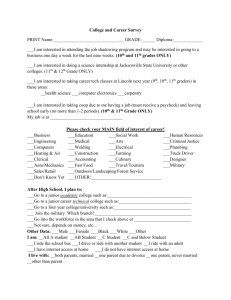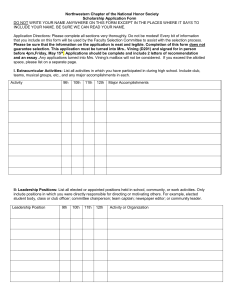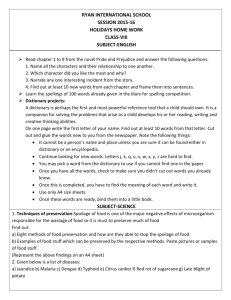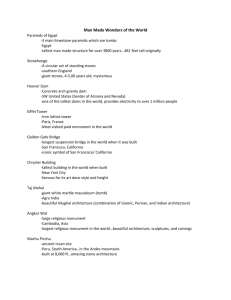Dear Colleagues,
advertisement
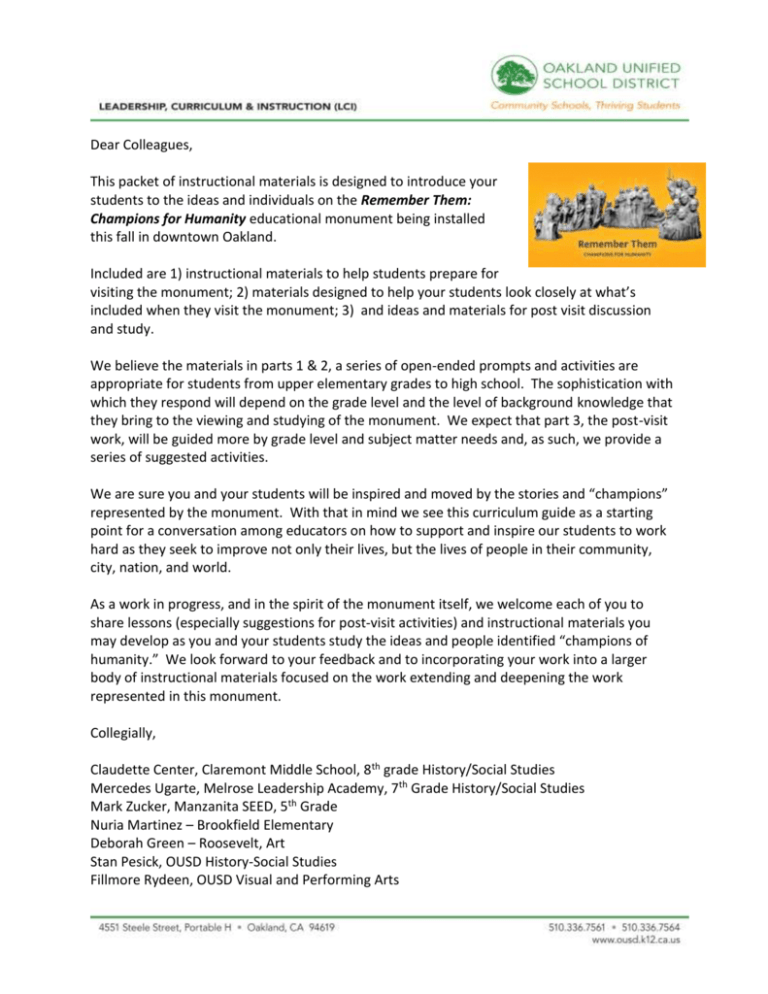
Dear Colleagues, This packet of instructional materials is designed to introduce your students to the ideas and individuals on the Remember Them: Champions for Humanity educational monument being installed this fall in downtown Oakland. Included are 1) instructional materials to help students prepare for visiting the monument; 2) materials designed to help your students look closely at what’s included when they visit the monument; 3) and ideas and materials for post visit discussion and study. We believe the materials in parts 1 & 2, a series of open-ended prompts and activities are appropriate for students from upper elementary grades to high school. The sophistication with which they respond will depend on the grade level and the level of background knowledge that they bring to the viewing and studying of the monument. We expect that part 3, the post-visit work, will be guided more by grade level and subject matter needs and, as such, we provide a series of suggested activities. We are sure you and your students will be inspired and moved by the stories and “champions” represented by the monument. With that in mind we see this curriculum guide as a starting point for a conversation among educators on how to support and inspire our students to work hard as they seek to improve not only their lives, but the lives of people in their community, city, nation, and world. As a work in progress, and in the spirit of the monument itself, we welcome each of you to share lessons (especially suggestions for post-visit activities) and instructional materials you may develop as you and your students study the ideas and people identified “champions of humanity.” We look forward to your feedback and to incorporating your work into a larger body of instructional materials focused on the work extending and deepening the work represented in this monument. Collegially, Claudette Center, Claremont Middle School, 8th grade History/Social Studies Mercedes Ugarte, Melrose Leadership Academy, 7th Grade History/Social Studies Mark Zucker, Manzanita SEED, 5th Grade Nuria Martinez – Brookfield Elementary Deborah Green – Roosevelt, Art Stan Pesick, OUSD History-Social Studies Fillmore Rydeen, OUSD Visual and Performing Arts Introduction to the Monument and Themes to Explore Below are a description of the monument and the educational vision of its creator, Oakland artist and sculpture Mario Chiodo. With installation scheduled for this fall this monument will be an inspiring, larger-than life bronze sculpture depicting 25 culturally diverse role models who have made significant contributions toward global peace, freedom and human rights over the past 150 years. The fullsize educational monument will be installed in a new park in a busy downtown Oakland neighborhood, and promises to draw tens of thousands of students annually from Oakland and the Bay Area. Measuring 52 feet long and 25 feet high, this will be the largest bronze monument in the western United States. A bold new vision for education and community development: Young people become inspired by the life lessons of humanitarians of differing ethnicity, gender, religion, race, sexual orientation, and nationality. Each relates to a different humanitarian, in whom they see themselves in some way. Learning about these humanitarians then helps young people of today to overcome their own challenges to become leaders themselves. Our youth see hope and promise in their future, and a path toward making positive change in their world. Young people and adults move beyond mere “tolerance” and toward the full embrace of diversity. Include the overarching themes that can be explored in history, literature, and writing. - from Remember Them: Champions of Humanity website -------------------------------------------1. The bullet points above identify specific themes and ideas that can be explored through the monument. Some additional instructional and analytical themes that can be explored in all grade levels and subject areas include: The influence of time and place on specific strategies people might choose as they struggle to change themselves and the world around them. The importance of education and literacy for both personal and societal change. What makes an individual and event historically significant – worth remembering? What can we learn about a specific time and place by studying the lives individuals? What does studying the life of an individual tell us about the specific time and place in which they lived? How does attempting to put ourselves in “someone else’s shoes,” and learning about the time and place they lived, help us understand the sometimes difficult choices they made as they worked to transform themselves and the world around them? 2. Working with the "champions of humanity" is also a means to investigate the specific historical time periods and places highlighted in the California State History-Social Studies Content Standards. The charts below identify specific places each of the twentyfive individuals included on the monument within the specific grade level and subject they would be taught. Individual Grade level - Subject 1. Cesar Chavez 4th – California History; 11th U.S. History 4th & 11th – U.S. History 4th & 11th - U.S. History 8th & 11th – U.S. History 8th & 11th U.S. History 8th & 11th - U.S. History 8th & 11th - U.S. History 10th World History 10th – World History 10th – World History 10th – World History 10th - World History & 11th U.S. History 10th - World History 10th - World History 10th - World History 10th – World History 2. Maya Angelou 3. Harvey Milk 4. Chief Joseph 5. Frederick Douglass 6. Abraham Lincoln 7. Susan B. Anthony 8. Winston Churchill 9. Mahatma Ghandi 10. Nelson Mandela 11. Elie Wiesel 12. Thich Nhat Hanh 13. Mother Theresa 14. Shirin Ebadi 15. Rigoberta Menchu 16. Unknown Demonstrator of Tiananmen Square 17. Oskar Schindler 18. Malcolm X 19. Martin Luther King, Jr. 20. Franklin D. Roosevelt 21. Rosa Parks 22. Ralph Abernathy 23. Ruby Bridges 24. Helen Keller 25. Coretta Scott King 10th – World History 11th – U.S. History 11th – U.S. History 11th – U.S. History 11th - U.S. History 11th – U.S. History 11th - U.S. History 11th - U.S. History 11th - U.S. History Key California State Content Standard 11.10.5 11.10.4 11.10.5; 11.10.6 8.12.2; 11.1.4; 8.9.1; 8.11; 11.1.4 8.9; 8.10.4; 11.1.4 8.6.6; 11.10.7 10.8.4 10.4.4; 10.9.4 10.10.1 10.8.5; 10.8.6 10.9 10.9.4 10.9 10.10.3 10.9.4; 10.10.3 10.8.5; 10.8.6 11.10.4 11.10.4 11.6.; 11.7.4 11.10.4 11.10.4 11.10.3 11.10.7 11.10.4 Artistic themes to Explore: In addition to Language Arts and History Themes many visual arts themes can be explored with this series of lessons. Artistic Perception: Processing, Analyzing, and Responding to Sensory Information Through the Language and Skills Unique to the Visual Arts. Students perceive and respond to works of art, objects in nature, events, and the environment. They also use the vocabulary of the visual arts to express their observations. Creative Expression: Creating, Performing, and Participating in the Visual Arts. Students apply artistic processes and skills, using a variety of media to communicate meaning and intent in original works of art. Historical and Cultural Context: Students analyze the role and development of the visual arts in past and present cultures throughout the world, noting human diversity as it relates to the visual arts and artists. Aesthetic Valuing: Responding to, Analyzing, and Making Judgments About Works in the Visual Arts Students analyze, assess, and derive meaning from works of art, including their own, according to the elements of art, the principles of design, and aesthetic qualities. Connections, Relationships and Applications: Connecting and Applying What Is Learned in the Visual Arts to Other Art Forms and Subject Areas and to Careers. Students apply what they learn in the visual arts across subject areas. They develop competencies and creative skills in problem solving, communication, and management of time and resources that contribute to lifelong learning and career skills. Visual & Performing Arts Standards Grade 1.0 Artistic Level Perception 2.0 Creative Expression 3.0 Historical 4.0 Aesthetic and Cultural Valuing Context 4 5 1.1 1.1 3.1 6 7 8 1.2 1.4 1.2 2.3, 2.5 2.2, 2.4, 2.5, 2.7 2.1, 2.4, 2.5 2.4, 2.6 3.1 3.1 4.1, 4.2, 4.5 4.1, 4.1, 4.2, 4.1, 4.2, 4.3 4.2, 4.3 5.0 Connections, Relationships, Applications 5.1, 5.3, 5.4 5.2, 5.3 5.3, 5.4
